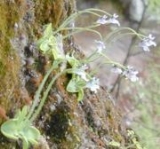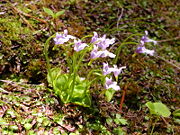
Pinguicula ramosa
Encyclopedia
Pinguicula ramosa is a species of butterwort
, a carnivorous plant
, endemic to the mountains of Nikkō National Park
in Japan
. It belongs to the section micranthus and is closely related to Pinguicula variegata. It is unique in the genus for having a forked flower stalk.
composed of five to six succulent leaves supported by a fine network of fibrous roots. The 8–15 mm long, 5–8 mm wide light-green leaves are elliptic
to spatulate
and curl in slightly at the margins. As with all butterworts, the leaves are densely covered with glandular hairs attract, trap, and digest arthropod prey to supplement the poor nutrient availability of its environment. During winter dormancy
the plant forms a small hybernaculum, from which it re-emerges in April.

s in June or July. The 7–11 mm flowers have a three-lobed upper lip and a two-lobed lower lip. The petal lobes are ovate-lanceolate
, pubescent, and violet or white in color. The spur (an extension of the floral tube) is conical and reaches a length of 3–4 mm.
Fertilized flowers form an obovate
to elliptic
seed pod 2–4 mm long and 2–3 mm wide. The chromosome count for the species is 2n=18, another unique feature within the genus
.
in Japan
, particularly on Mount Koshin, between 1500 and 1900 m in altitude. Two mountains outside of the park, Mount Kesamaru and Mount Ozaku-san, also host populations. Here P. ramosa colonizes weathered granite rocks and volcanic cliffs in damp, foggy locations in full or partial shade. The species is frequently associated with Saxifraga fortunei and Primula modesta.
P. ramosa is endangered due to its small distribution, as well as the degradation of its habitat through rock degradation from acid rain
and climbing activities, as well as herbivory from deer
. While the species is strictly protected under Japanese law, its future remains uncertain.
Pinguicula
The butterworts are a group of carnivorous plants comprising the genus Pinguicula. Members of this genus use sticky, glandular leaves to lure, trap, and digest insects in order to supplement the poor mineral nutrition they obtain from the environments. Of the roughly 80 currently known species, 12...
, a carnivorous plant
Carnivorous plant
Carnivorous plants are plants that derive some or most of their nutrients from trapping and consuming animals or protozoans, typically insects and other arthropods. Carnivorous plants appear adapted to grow in places where the soil is thin or poor in nutrients, especially nitrogen, such as acidic...
, endemic to the mountains of Nikkō National Park
Nikko National Park
is a national park in the Kantō region, on the main island of Honshū in Japan. The park spreads over four prefectures: Tochigi, Gunma, Fukushima, and Niigata.Notable attractions include:* Nikkō Tōshō-gū* Lake Chūzenji* Kegon Falls* Ryūzu Falls* Mount Nantai...
in Japan
Japan
Japan is an island nation in East Asia. Located in the Pacific Ocean, it lies to the east of the Sea of Japan, China, North Korea, South Korea and Russia, stretching from the Sea of Okhotsk in the north to the East China Sea and Taiwan in the south...
. It belongs to the section micranthus and is closely related to Pinguicula variegata. It is unique in the genus for having a forked flower stalk.
Habit
Pinguicula ramosa forms a ground-hugging rosetteRosette (botany)
In botany, a rosette is a circular arrangement of leaves, with all the leaves at a single height.Though rosettes usually sit near the soil, their structure is an example of a modified stem.-Function:...
composed of five to six succulent leaves supported by a fine network of fibrous roots. The 8–15 mm long, 5–8 mm wide light-green leaves are elliptic
Leaf shape
In botany, leaf shape is characterised with the following terms :* Acicular : Slender and pointed, needle-like* Acuminate : Tapering to a long point...
to spatulate
Leaf shape
In botany, leaf shape is characterised with the following terms :* Acicular : Slender and pointed, needle-like* Acuminate : Tapering to a long point...
and curl in slightly at the margins. As with all butterworts, the leaves are densely covered with glandular hairs attract, trap, and digest arthropod prey to supplement the poor nutrient availability of its environment. During winter dormancy
Dormancy
Dormancy is a period in an organism's life cycle when growth, development, and physical activity are temporarily stopped. This minimizes metabolic activity and therefore helps an organism to conserve energy. Dormancy tends to be closely associated with environmental conditions...
the plant forms a small hybernaculum, from which it re-emerges in April.

Flowers
The 15–90 mm long flower stalks are unique in the genus in being forked near their base. The stalks are densely covered with glandular hairs (like the leaves) and support 2-3 zygomorphic flowerFlower
A flower, sometimes known as a bloom or blossom, is the reproductive structure found in flowering plants . The biological function of a flower is to effect reproduction, usually by providing a mechanism for the union of sperm with eggs...
s in June or July. The 7–11 mm flowers have a three-lobed upper lip and a two-lobed lower lip. The petal lobes are ovate-lanceolate
Leaf shape
In botany, leaf shape is characterised with the following terms :* Acicular : Slender and pointed, needle-like* Acuminate : Tapering to a long point...
, pubescent, and violet or white in color. The spur (an extension of the floral tube) is conical and reaches a length of 3–4 mm.
Fertilized flowers form an obovate
Leaf shape
In botany, leaf shape is characterised with the following terms :* Acicular : Slender and pointed, needle-like* Acuminate : Tapering to a long point...
to elliptic
Leaf shape
In botany, leaf shape is characterised with the following terms :* Acicular : Slender and pointed, needle-like* Acuminate : Tapering to a long point...
seed pod 2–4 mm long and 2–3 mm wide. The chromosome count for the species is 2n=18, another unique feature within the genus
Genus
In biology, a genus is a low-level taxonomic rank used in the biological classification of living and fossil organisms, which is an example of definition by genus and differentia...
.
Distribution, habitat, and environmental status
Pinguicula ramosa is grows almost exclusively on mountains in Nikkō National ParkNikko National Park
is a national park in the Kantō region, on the main island of Honshū in Japan. The park spreads over four prefectures: Tochigi, Gunma, Fukushima, and Niigata.Notable attractions include:* Nikkō Tōshō-gū* Lake Chūzenji* Kegon Falls* Ryūzu Falls* Mount Nantai...
in Japan
Japan
Japan is an island nation in East Asia. Located in the Pacific Ocean, it lies to the east of the Sea of Japan, China, North Korea, South Korea and Russia, stretching from the Sea of Okhotsk in the north to the East China Sea and Taiwan in the south...
, particularly on Mount Koshin, between 1500 and 1900 m in altitude. Two mountains outside of the park, Mount Kesamaru and Mount Ozaku-san, also host populations. Here P. ramosa colonizes weathered granite rocks and volcanic cliffs in damp, foggy locations in full or partial shade. The species is frequently associated with Saxifraga fortunei and Primula modesta.
P. ramosa is endangered due to its small distribution, as well as the degradation of its habitat through rock degradation from acid rain
Acid rain
Acid rain is a rain or any other form of precipitation that is unusually acidic, meaning that it possesses elevated levels of hydrogen ions . It can have harmful effects on plants, aquatic animals, and infrastructure. Acid rain is caused by emissions of carbon dioxide, sulfur dioxide and nitrogen...
and climbing activities, as well as herbivory from deer
Sika Deer
The Sika Deer, Cervus nippon, also known as the Spotted Deer or the Japanese Deer, is a species of deer native to much of East Asia and introduced to various other parts of the world...
. While the species is strictly protected under Japanese law, its future remains uncertain.

